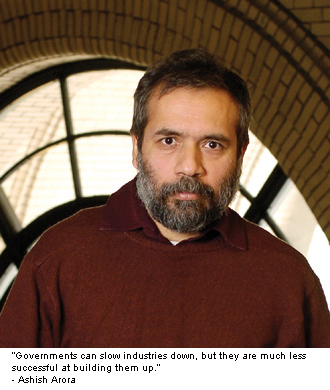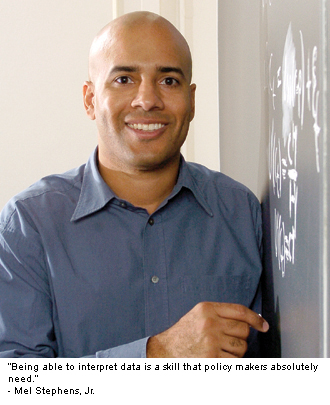Heinz School faculty bring together a range of tools and perspectives on public problems
The H. John Heinz III School of Public Policy and Management has never been your average policy school. It has no departments. Students spend a lot of time out in the community, and that community might be in Australia or Pittsburgh or somewhere altogether different. Its faculty members are likely to be found perusing everything from a medical journal to U.S. consumption statistics to Variety.

William Cooper, the school’s first dean, said that the Heinz School’s goal was “to prepare men and women for intelligent action.” This is not just talk: in the school’s various master’s programs; students are encouraged to be focused, action-oriented problem solvers for real-world organizations.
Yet the Heinz community is also characterized by faculty who take a wide-ranging and big-picture view of their subjects, using computation, statistics, or behavioral analysis to understand the most complex of human problems—always with an eye on intelligent solutions. Here are three stories.
Jonathan Caulkins:
A mathematician looks at what works and what doesn’t in America’s war on drugs
For more than 15 years, Professor Jonathan Caulkins has turned his mathematical model-building talents to one of the most intractable and emotion-laden social questions of all: drug abuse.
“America’s drug problem is more severe than that of any other developed country,” Caulkins says. “America has more drug dependence, more overdose deaths, more drug-related HIV-infections, and more drug-related violence. Its impact is widespread and costly; it taxes our criminal justice system, our hospitals, our schools. The cost in dollars and in lives is enormous.”

Yet, despite these high stakes, Caulkins believes that much of U.S. policy is distorted by wishful thinking, bureaucratic silos, and simple misinterpretation of the data. “When you have such a long term and costly problem as drug use has been, it makes sense to root strategies in objective evidence of what works and what doesn’t,” Caulkins says. “We have not always done that.”
After leading the Drug Policy Research Center at the Rand Corporation and designing innovative and influential efforts to assess cocaine control strategies, Caulkins became concerned that the lessons from cocaine were being generalized too broadly to other drugs at different stages in the cycle of adoption. When experts in dynamic modeling approached him about marrying methods from mathematical biosciences, epidemiology, and product diffusion modeling with traditional drug policy analysis, Caulkins jumped at the opportunity.
He now brings this dynamic modeling perspective to a range of problems pertaining to drugs, crime, violence, delinquency and prevention to understand the effect of policy initiatives on those problems as they evolve over time.
The markets for drugs are in some crucial respects not really that different from markets for other types of consumer products. Consumer product marketers, of course, want to expand product sales, while drug policy makers want to curtail them, but the underlying math of the models is the same, Caulkins says.
Drug use follows well-documented cycles of introduction, growth, and maturity. A newer drug, such as methamphetamine, requires a different response than does a “mature” product such as heroin or cocaine. Just as marketers use different tactics with brand new products and established brands, so the approaches to curbing drug use must differ.
“We need to make data-driven decisions about when to emphasize prevention and when to emphasize enforcement,” Caulkins says. “No one approach is the single right answer at every point. In the early phase of a drug epidemic, for example, treatment programs are not as important as they are in the later stages, when users are older, have more health problems, and may be more compliant with treatment. On the other hand, law enforcement has a much more dramatic impact on containing the spread of a drug early in the cycle, but almost none once a drug is in widespread use.”
Caulkins’s fresh approach is attracting attention. He was named a Robert Wood Johnson Foundation Health Policy Fellow in 2006, which is supporting his current project, “Synthesizing Lessons for Drug Policy and Policy Research.”
“We will not have more success in coping with drug abuse until we have a more dispassionate debate,” Caulkins says. “We must look more systematically at what has worked and when it has worked.
“Let’s take a more dynamic approach to respond to a dynamic problem.”
Ashish Arora
Why are some nations rich and others poor?
Adam Smith’s The Wealth of Nations is on the course reading list in the new Heinz School class “Technology and Economic Growth,” which Professor Ashish Arora is teaching this fall with his colleague Lee Branstetter.

The question that interested Adam Smith in 1776 is still very much on Professor Arora’s research agenda: why are some nations so rich and others so poor?
Being a 21st century economist, however, Arora is much more interested than Smith was in the role of technology in creating national wealth and opportunity.
“It is important to remember how new technology is a factor in economic growth—‘the systematic application of science to economic ends’ to use economist Simon Kuznets’s phrase, was just beginning in Adam Smith’s time. For him, in the first years of the Industrial Revolution, this was too new to recognize,” Arora says.
The role of technology in economic growth has been one of the hottest topics in economics in recent years. Arora has pursued this question in his studies of the chemical, software, and biopharmaceutical industries over time and across the world.
“Economists have looked at the value of being first-to-market with a technology, or the stability of the banking sector, and so on, but two ideas emerge in our studies,” Arora says.
“First, the role of company managers and entrepreneurs is pivotal; second, technical leads are very, very fleeting and bring no guarantee of lasting market dominance."
Arora cites the British chemical industry to illustrate both these observations.
“Britain was the dominant producer of chemical dyes in the 1860s, but they lost the lead to Germany within a generation,” Arora says. “Why was that? The British had the technical edge; they had the best chemists; they had the customers (in the textile mills); and they had the raw materials (in coal tar). Britain’s political, financial and patent law systems were much more developed and stable than they were Germany, which had barely become a unified nation at that time. Britain had all the advantages, but Germany raced ahead, both in the market and technically.”
So what went wrong? “British managers simply failed to recognize the potential of other chemicals or out of complacency chose not to exploit the opportunities at their feet,” Arora says. “German firms quickly filled the vacuum British management left.”
Another story: why has India succeeded in creating a thriving software industry, when the Philippines have not? Both nations produce qualified, English-speaking engineers. Yet the Philippines’ software sector has sputtered along, while India’s is a roaring success story with $20 billion annual revenues (up from $15 million in the mid-1980s). Indian startups were greatly strengthened by the network of Indian expatriates living in the U.S. who became important brokers in connecting Indian providers and their American clients. The labor-intensive efforts to rewrite software code around “Y2K” dates were a huge boost to the sector, and Indian entrepreneurs successfully built on that.
Arora says that a third emerging idea is the role of effective legal protection of intellectual property rights, such as patents.
“Patent protection stimulates companies to invest in R&D, because they have confidence their investment will pay off for them, and they encourage markets for ideas and technology. Biotechnology and semiconductors are two industries where startups have relied heavily upon such markets to unlock the value of their innovative technology,” Arora says.
Building an effective patent system may be one of the only ways governments can really strengthen technology industries.
“I’m skeptical about the capacity of governments to do a great deal, particularly governments of developing countries, which face so many competing demands,” Arora says.
“Governments can slow industries down, but they are much less successful at building them up.”
Melvin Stephens, Jr.
Deciphering datasets
A two-foot stack of economic journals sits on the desk and two computer screens are blazing. Every square inch of the white board is filled with equations and u-shaped curves.

This is the office of Mel Stephens, the Raymond John Wean Career Development Professor of Economics at Heinz. Stephens uses large datasets to understand changes in economic decision making and how people alter their consumption behavior in response to change—as incomes fall or rise, as interest rates or gas prices fluctuate.
For example, he has studied how those who expect to lose their jobs change their expenditures (the surprising answer: not much). He has studied whether retirees spend more on the day they receive their Social Security check than they do on other days; economic theory says since they know when the check is coming each month, they will not spend more that day, but in practice—well, they splurge a little.
Like some of his Heinz School colleagues, Stephens is also interested in analysis of social changes; he is one of those who have done controversial work on the widespread social effects of legalizing abortion after 1973. Some studies have linked this to the drop in the crime rate in the early 1990s. Stephens and his colleague, Kerwin K. Charles of the University of Chicago, found a connection between legalized abortion and reduced drug use among adolescents. This is not an argument for or against abortion, Stephens emphasizes, but simply an attempt to understand the complex and unpredictable reverberations from a well-defined social change.
Another of Stephens’s interests is in improving the tools of research and economic analysis. At Heinz, he teaches the electives in econometrics, the most mathematical and data-focused branch of economics, and he gets students from all the Heinz master’s degree programs.
“Being able to interpret data is a skill that managers and policy analysts absolutely need, in government, in business, and in the nonprofit world,” Stephens says. “They must understand research and the strengths and limitations of various methods and tools—what a decision-maker can and cannot learn from observational study, or what statistical analyses they might choose to clarify certain issues.”
Related Links:
Carnegie Mellon Heinz School
Jonathan Caulkins
Rand Corporation
Robert Wood Johnson Foundation Health Policy Fellowship
Ashish Arora
Adam Smith
The Wealth of Nation’s
Melvin Stephens, Jr.
Professor Stephens Research



